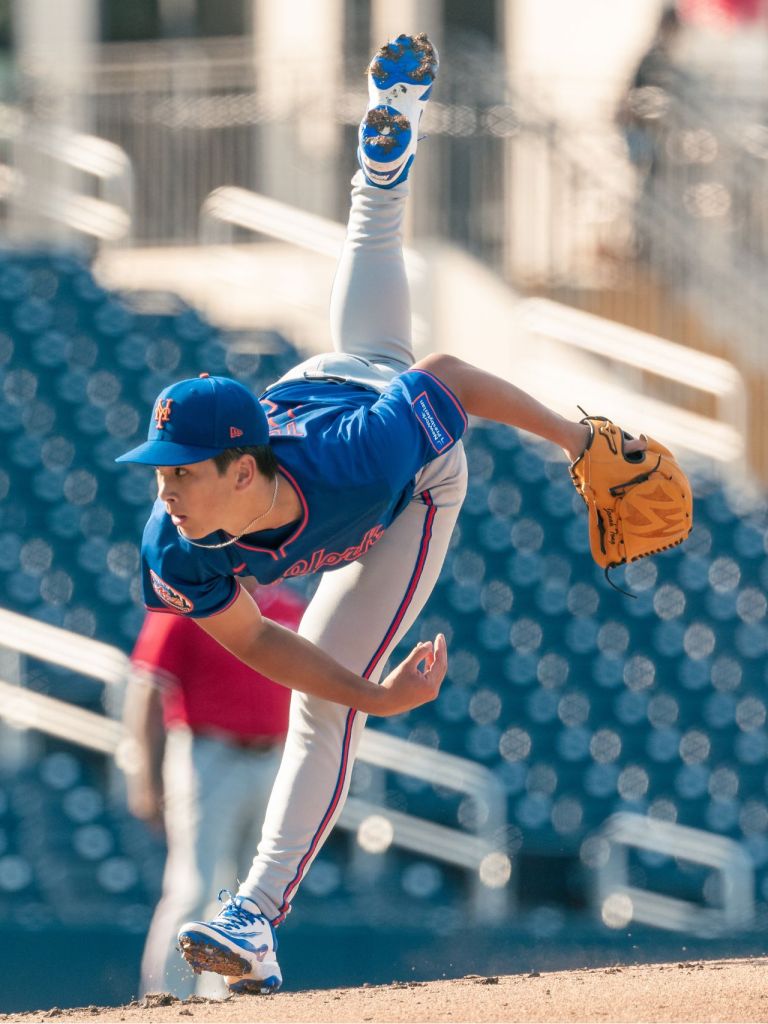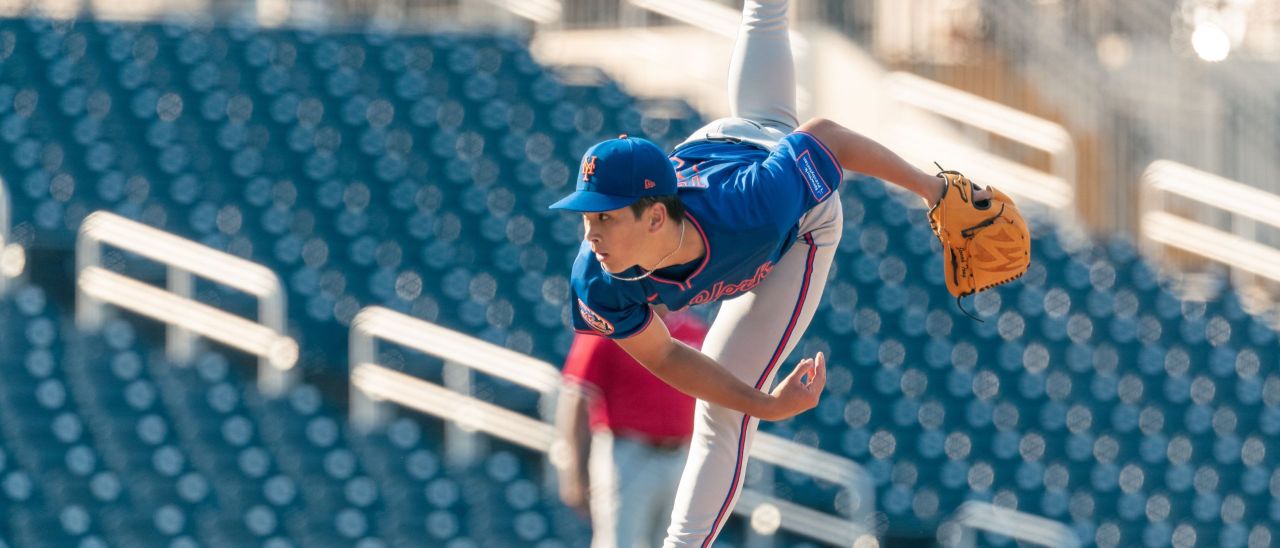5 Breakout MLB Pitching Prospects Who Have Raised Their Stock In 2025


Image credit: Jonah Tong (Photo by Jared Blais/MLB Photos via Getty Images)
As we reach the halfway point of the season, it’s becoming clearer which breakout prospects are the real thing. This collection of upstart pitchers have significantly raised their stock and increasingly find themselves being mentioned among the best up-and-coming pitching prospects in the minors.
Today, we’ll examine five such breakout pitchers who have shown they possess a variety of pathways to generating outs. We’ll dig into their backgrounds, success in 2025 and pitch mixes, with the ultimate goal of forming a more complete understanding of the types of pitchers these prospects project to develop into.
Jonah Tong, RHP, Mets
After a dozen starts, Tong has pitched his way onto the back end of the Top 100 Prospects list and looks like he’s headed to even greater heights over the next few months.
Tong’s development of his changeup has led to increased results, as it’s resulted in less contact overall and a spike in groundball rate. Tong’s ability to generate whiffs (15.5% swinging-strike rate) and ground balls (55.2% rate) gives him the ability to get outs in a variety of fashions. His fastball is still his go-to pitch and the crown jewel of his arsenal, however, and he’s sitting more mid 90s now compared to the low 90s he was getting in 2024.
When you take a step back and assess Tong’s development, it’s clear he’s coming into his own as he improves in a multitude of areas. The biggest remaining concern is his fringy command. While he’s adept at getting chase swings out of the zone, his lack of precision is still leading to higher walk rates overall.
Tong looks like a potential long-term midrotation option for the Mets and could debut later this summer for the team.
Jaxon Wiggins, RHP, Cubs
Wiggins has always hinted at immense potential dating back to his days at Arkansas, but a lack of execution coupled with Tommy John surgery prior to the draft in 2023 made him a risky pick that summer. The Cubs selected Wiggins in the supplemental second round, signing him for just above $1.4 million. He made his professional debut in 2024, totaling 59.2 innings between the Arizona Complex League, Low-A and High-A.
In 2025, we’ve seen Wiggins emerge across 12 impressive appearances. His season up to this point has been evenly split between High-A and Double-A, spanning 56.1 innings in which he has pitched to a 1.92 ERA and 2.52 FIP while striking out 31.3% of batters faced. His strike-throwing has been solid, as well, with a 10.3% walk rate on the season.
Wiggins is a pure power pitcher. He mixes a mid-to-high-90s four-seam fastball featuring above-average ride and armside run with a mid-to-high-80s changeup, a cutter-like slider and a curveball. There’s some depth within Wiggins’ mix, and he’s learning to get more efficient from start to start.
Wiggins checks multiple boxes as a potential upside starter who could settle into a midrotation role for the Cubs in the coming years.
Gage Stanifer, RHP, Blue Jays
Entering the season, few people outside of detail-obsessed Blue Jay fans were aware of Stanifer. A 19th-round pick in 2022 out of the Indiana prep circuit, Stanifer took a few seasons to gel on the complex. Things began to turn a corner early this season, as he piggybacked with Blue Jays 2024 first-round pick Trey Yesavage over the opening months of the season with Low-A Dunedin.
Stanifer made seven appearances for the Low-A squad, pitching to a preposterous 0.69 ERA over 26 innings. Since his bump to High-A, he has continued to perform as the team has begun to use him in a more traditional starter’s role. Across both levels this season, Stanifer is 4-1 with a 1.80 ERA across 45 total innings spanning a dozen appearances.
Stanifer, like others included on this list, has a variety of pathways to generating outs, making him less one-dimensional than similar pitching prospects with a heavy dose of relief risk. He has struck out 40.9% of batters faced this season backed by a 17.5% swinging-strike rate. He’s also displayed an ability to drive contact on the ground at a high rate, boasting a 51.3% groundball rate so far this season.
Stanifer’s stuff is notable. He’s sitting mid 90s on a four-seam fastball that generates up to 20 inches of induced vertical break regularly. His go-to secondary is a mid-80s breaking ball he calls a slider with slurvy shape and good depth for its velocity. He’ll also show a changeup, but it’s used less often than his slider by a wide margin.
While Stanifer still presents quite a bit of relief risk, his improving stuff and ability to generate both whiffs and ground balls should buy him time to improve and expand his pitch mix.
Braxton Bragg, RHP, Orioles
Things have changed in the Orioles’ farm system over the last two seasons. Not long ago considered one the top systems in the game, Baltimore has graduated a glut of positional talent in recent years, leaving the organization’s farm thin for the first time in while. Though this is concerning, a new narrative is beginning to emerge for the Orioles: The talent now seems to lay within their minor league pitching corps.
Bragg is one of the primary names among this young and talented pitching core. After three starts with High-A Aberdeen to begin the season in which he did not allow an earned run, the righthander saw promotion to Double-A Chesapeake. Things have not slowed down over seven appearances in the Eastern League.
On the season, Bragg has pitched to a 1.24 ERA across 51 innings, and he’s struck out 33.5% of batters he faced while issuing free passes just 8% of the time. He has also shown the ability to get the ball on the ground when needed, as his groundball rate is in the neighborhood of 50%.
Bragg’s stuff backs his success, as he mixes two fastball shapes in a four-seamer and true sinker, a changeup, a cutter and a sweeper slider. Last year, Bragg used the four-seam as his primary pitch, but this season, the sinker has seen a 50% increase in usage, which has led to more ground balls and swing-and-miss. It’s a true sinker sitting 94-95 mph with seven inches of induced vertical break and 18-19 inches of armside run on average. His changeup plays perfectly off this pitch and features a negative induced vertical break and around 11-12 inches of armside run. The change boasts above-average vertical and velocity separation off his two fastball shapes, too. Despite fringe quality on both his cutter and slider, he’s continued to use each pitch at a higher clip.
The biggest challenge facing Bragg moving forward will be improving the quality of his breaking balls as a way to make his overall arsenal more effective.
Cam Schlittler, RHP, Yankees
The Yankees landed the 6-foot-6 Schlittler in the seventh round of the 2022 draft out of Northeastern. The Massachusetts native had flashed tantalizing upside at points as an amateur both with the Huskies and in the Cape Cod League in 2021. His inconsistency proved to be his greatest hurdle, as Schlittler’s stuff could fluctuate from start to start. After an impressive 2024 season in which he pitched to a 3.36 ERA across 120.2 innings between High-A and Double-A, he entered the 2025 season with legitimate buzz.
In 12 appearances across Double-A and Triple-A, the 24-year old is now coming into his own. Over 63.1 innings this season, Schlittler owns a 2.27 ERA, 2.54 FIP and 2.71 xFIP, leading to belief that his dominance this year is in line with his true talent. The giant righthander’s ability to generate outs in a variety of manners has been his selling point. He has a 13.6% swinging-strike rate this season across both levels of the upper minors while also getting ground balls at a rate of 48.3%.
Schlittler stuff is above-average but not outlier, and he mixes a four-seam fastball, slider, curveball and changeup. His four-seam fastball has cut-ride shape at 93-95 mph and touches 98 mph at peak. His slider is his main secondary weapon, and he deploys it 25% of the time or more. The slider sits mid 80s with ride-sweeper shape, allowing him to generate whiffs on the pitch consistently. Schlittler’s curveball is a two-plane banger with good depth and late gloveside break. His changeup gets below-average separation off his fastball and is a less-effective offering than his other secondaries.
Schlittler is more than likely a backend rotation piece in the coming years, as he’s unlikely to add the type of stuff to project as midrotation-or-better arm.
